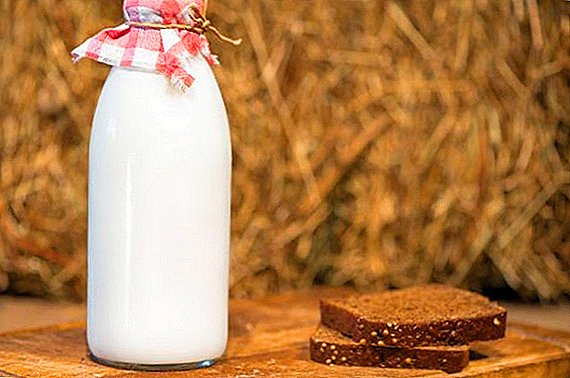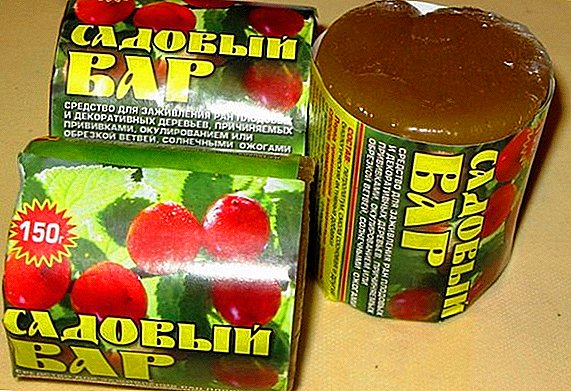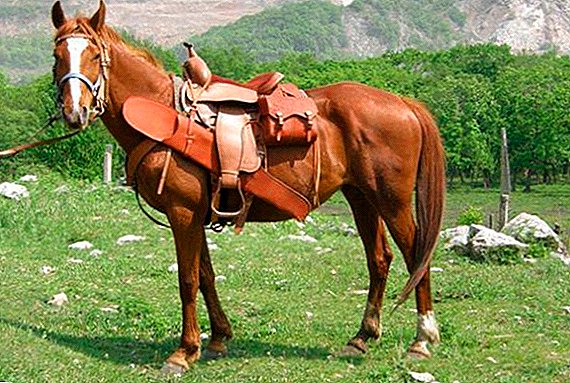 Before riding a horse, it must be saddled. A well-fitting saddle makes dressing comfortable for both rider and animal. In addition to the saddle, to control the animals need to wear a bridle. In addition: in order for the horse to be pleasant to walk under the saddle, it is necessary to follow certain rules of the saddle. This article will cover the basics of preparing a horse for saddling, putting on a cinch and fastening a saddle, principles of boarding a horse.
Before riding a horse, it must be saddled. A well-fitting saddle makes dressing comfortable for both rider and animal. In addition to the saddle, to control the animals need to wear a bridle. In addition: in order for the horse to be pleasant to walk under the saddle, it is necessary to follow certain rules of the saddle. This article will cover the basics of preparing a horse for saddling, putting on a cinch and fastening a saddle, principles of boarding a horse.
How to saddle a horse
Saddling takes place in several stages. It begins with the preparation of the animal for dressage.
We recommend reading about how to choose the right horse for yourself and how to name it.
Horse preparation
No need to think that a big and strong animal does not need your care.  Preparation must comply with strict rules:
Preparation must comply with strict rules:
- First of all, make sure that there are no litters, grains of sand and dried dirt from the previous dressage on the horse's skin. Remember that any mote will rub the horse's skin under your weight, and the animal will become nervous and naughty.
- Thoroughly brush the horse's hair with a comb, and then brush with a hard pile, starting from the muzzle and ending with the croup.
- Brush your horse's tail and mane.
- Alternately lift his legs and check for small pebbles and horseshoes and horseshoes in the shooter. If they are not removed, calluses will start to appear on the hooves.
- Inspect the animal - whether it has lymph nodes that have appeared, seals, cones, measure body temperature. It is not recommended to drive on an unhealthy animal.
- If the horse is fine, proceed to the saddle.
Important! Especially carefully brush the areas that will be covered with a saddle and cinch. Even irregularities from stuck wool will interfere with the animal and annoy it.
Installing the saddle on the back of the mount
Stroking the animal on the back - so you calm it down and at the same time be able to check if there are any irregularities and streaks on it. Carefully shake out and clean the bedcloth. In some cases it is allowed to use a thin woolen blanket folded in half.  A saddle pad will absorb fat and sweat, and the stallion's skin will be able to breathe under the saddle. Throw it at the base of the withers and gently slide it down onto its back, so that the wool under the racks lies along the growth line. Check if the bed is flat - the ends should hang evenly on both sides.
A saddle pad will absorb fat and sweat, and the stallion's skin will be able to breathe under the saddle. Throw it at the base of the withers and gently slide it down onto its back, so that the wool under the racks lies along the growth line. Check if the bed is flat - the ends should hang evenly on both sides.
Did you know? The stallion named Brooklyn is considered the heaviest horse in the world. He was born in the 30s of the last century and reached a weight of one and a half tons as an adult. The stallion Pumpkov is recognized as the smallest member of the horse family. At the age of the year, his weight was only nine kilograms, and his height - a little more than thirty five centimeters.Now you can install:
- Stand facing the stallion on the left side, take the saddle by the bows and gently place it at the base of the withers, moving it lower on the back just as you moved the potnik.
- If the saddle has become uneven or the sweat has shifted, remove the saddle, then sweat, and try putting it on again.
- If you put everything flat, the pot will be evenly visible from under the saddle on both sides. It should not touch the withers or be moved too low on the croup. If you leave the saddle at the withers, then in the process of riding it can damage the horse's cervical vertebrae. The saddle lying on the croup will rub the animal's lower back.

- Go around the front of the stallion and straighten the girths so that they are not twisted.
- Return to the left side of the animal and gently hold the front girth under his belly.
- Take the sling strap hanging from the saddle and push it into the girth ring. Do not tighten the pristugu immediately for dressage - the horse, feeling instant discomfort, can strain the stomach, and then relax it, and the saddle will be poorly fastened.
Important! If the animal bristles while tightening the pristagi, give it a piece of apple or carrot. The horse will begin to chew, and her belly will relax itself. Do not beat your horse with your knee in the stomach. Some groomsak do, but it causes the animal discomfort and sets it against you.
Tighten the tool gradually.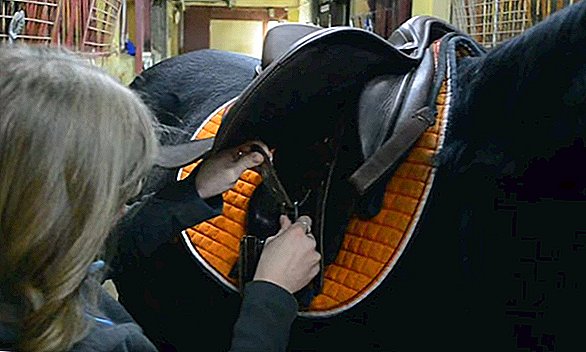
- To fix the tool, run it through the ring several times, through which it is hooked on the saddle. Wrap the remaining tip horizontally around the strap, guide it through the seat ring, and thread it into the resulting loop. Tighten the loop, and the pristuga will be fixed.
- Now move the stallion in slow pace. This will straighten the skin that has been pulled under the bristle and will allow the animal to relax.
- Pull the prisruga a little more, so that it tightly pressed the girth to the chest of the animal.
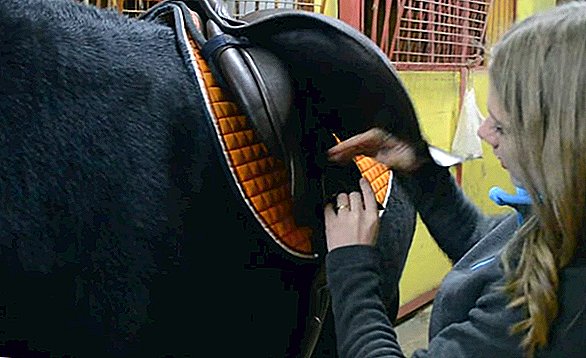
- The rear girth is buckled and falls free. You will need to hold it under the horse's belly and put a buckle in it, leaving a two-finger-width from the girth to the belly. If you put on the saddle and fasten it properly, the distance from the front girth to the front legs of the horse will be the width of the palm.
Video: how to saddle a horse
Putting on the bridle
The bridle is designed to control the horse and consists of three parts - snaffle (fished), reins and belts.
- First, straighten all the straps so that they do not rub the horse's skin.
Important! There are protruding thin bones near the ears and nose of the horse. Make sure that the bridle does not lay on them, since its belts are quite rigid and during dressage they can rub the horse’s face to hematomas.
- Then come to him from the left shoulder and put your hand on his nose. Throw the reins on the animal's neck, take the snaffle with your left hand and put it into the horse's mouth so that it lies on the toothless part of the jaw between the fangs and the molars.
- Lift the straps to your ears and put the bridle on so that your ears are between the forehead and the neck straps.
- Straighten the belts, pull the bangs out from under them.
- Loosely fasten the chin strap - it should not hamper the movement of the head.
- The cap on the nose tighten moderately tight so that the snaffle does not slip out of his mouth.
How to ride a horse
If everything is done correctly - you can sit down:
- Stand at the left shoulder of the horse and lower the stirrups attached to the saddle.

- Take a halter and a lock of horse's mane in your left hand. Do not grab the saddle bow to prevent it from moving.
- Hold the stirrup with your right hand and push your left foot into it.
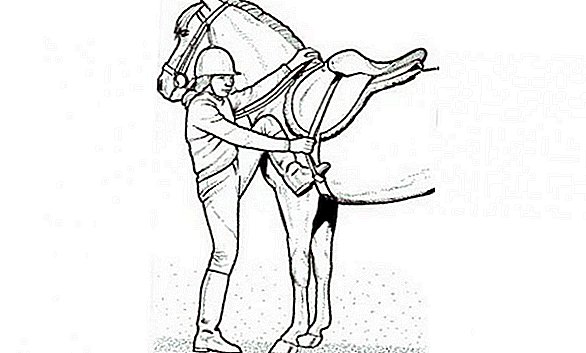
- Release the stirrup. Grasp the rear bow of the saddle and, pushing off with your right foot, stand in the stirrup.
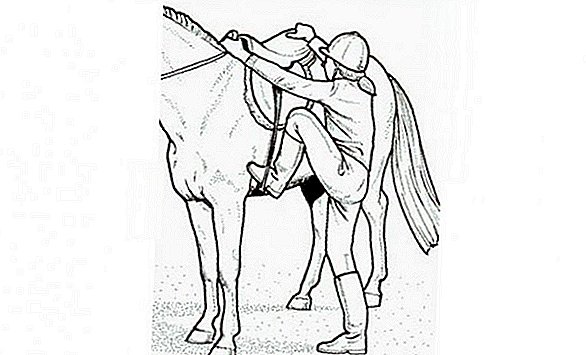
- Grasp the front bow with your right hand, throw your right leg over the croup and push it into the right stirrup.

- Tighten the knotles, which hold the stirrups, so that the knee is slightly bent. It is possible to tighten the knapsacks in motion so that the saddled animal does not get nervous.
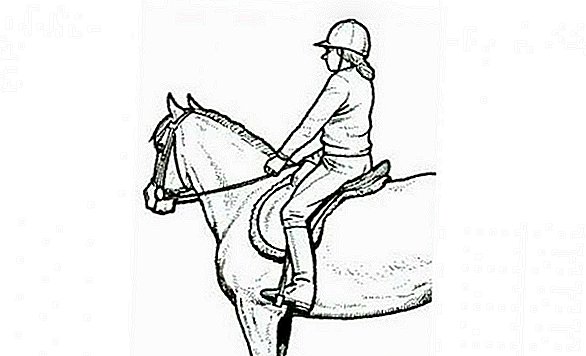
The horse saddle and bridle are designed for safe and comfortable riding. But in order for them to properly perform their functions, it is necessary to put them on the horse in accordance with the physiology of the animal, following the recommendations that have been developed over many centuries.
Did you know? On average, the life span of a horse is no more than forty years. The famous record of longevity belongs to a Cleveland breed horse named Billy. This hard worker was born in the 1760s in England. The first sixty years of his life, Billy worked on barges, and in 1819 he was sent to retire and lived on a farm until his death in the autumn of 1822.Properly worn and fastened harness will give you the opportunity to easily control the animal and keep it on horseback.










